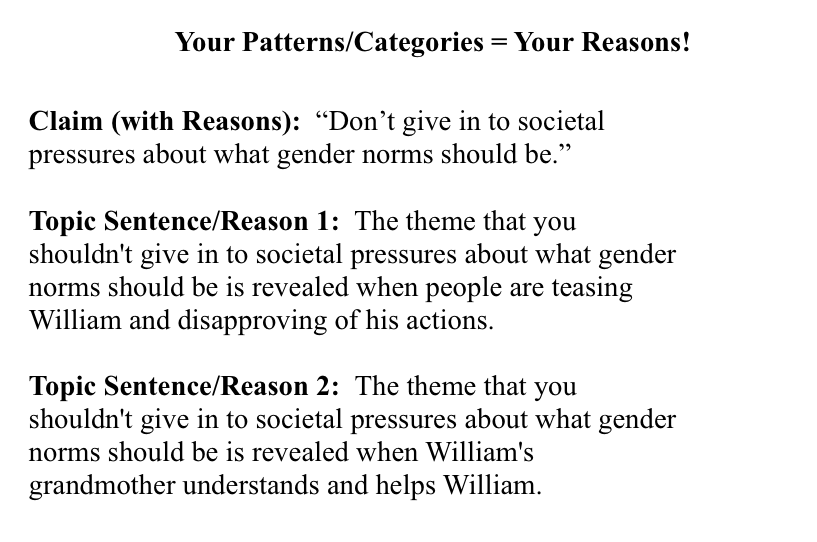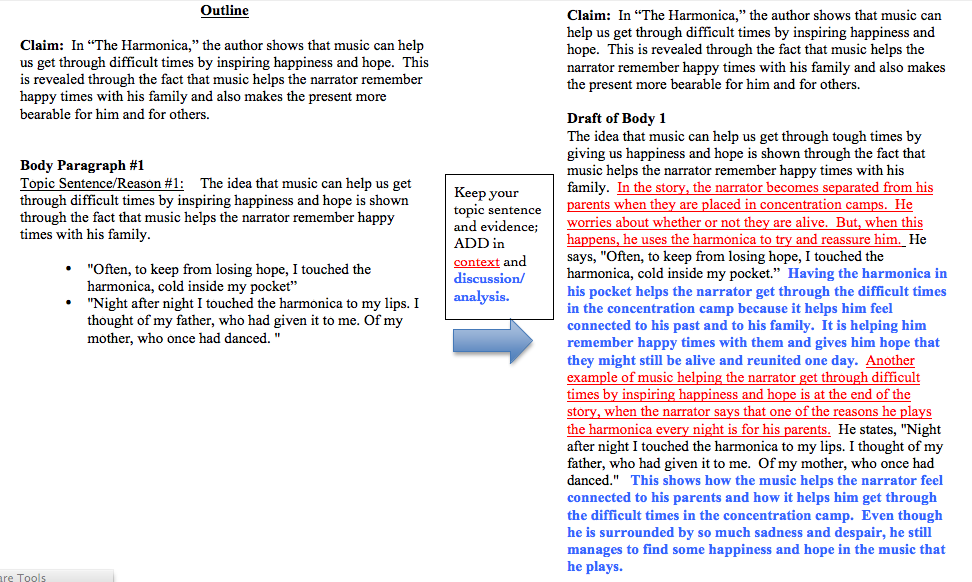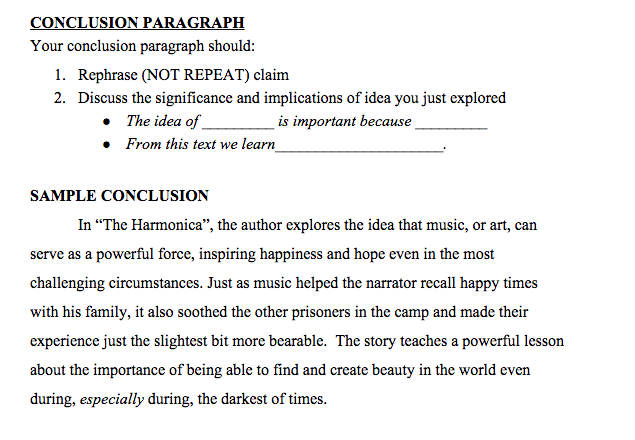literary essay
LITERARY ESSAY STRUCTURE
Intro Paragraph
· Relevant background info- including title, author, brief plot summary
· Claim (with reasons stated in it)
Body Paragraphs (2-3)
· Topic Sentence (reason)
· Set up/introduce quote/explain context
· Quote (evidence)
· Analysis (explain significance of quote- how it connects back to topic sentence)
· Closing/clincher sentence- ties it all together
*Each body paragraph should have 2-3 quotes*
Conclusion
· Rephrase (NOT repeat) claim
· Connect to larger picture/discuss significance and implications of the idea you just explored
lessons:
Strong writers craft thoughtful and sophisticated claims about theme by paying attention to word choice and by asking themselves questions like “Why?” and “How?”
When trying to raise the level of your theme and make it more sophisticated, it is helpful to ask yourself some questions:
Example:
Text: "The Harmonica"
Claim Version #1: “Music is important.”
Claim Version #2: “Music can inspire hope.”
Claim Version #3: “Music can help us get through tough times by reminding us of times of happiness and hope.”
Claim Version #4: “Music can help us get through difficult times by reminding us of times of happiness and hope.”
- WHY is this the case?
- HOW can I make this idea more related to the events in the story?
- HOW can I play with words and phrasing to communicate how this idea is shown in the story more clearly?
Example:
Text: "The Harmonica"
Claim Version #1: “Music is important.”
- WHY is this the case?
Claim Version #2: “Music can inspire hope.”
- How can I make this theme more related to the events in the story?
Claim Version #3: “Music can help us get through tough times by reminding us of times of happiness and hope.”
- HOW can I play with words and phrasing to communicate this idea more clearly?
Claim Version #4: “Music can help us get through difficult times by reminding us of times of happiness and hope.”
Strong writers identify reasons that support their claim by looking over the evidence they’ve collected and noticing patterns.
Text: William's Doll
Theme/Claim: “Don’t give in to societal pressures about what gender norms should be.”
Theme/Claim: “Don’t give in to societal pressures about what gender norms should be.”
Good writers communicate ideas clearly by supporting their claims with specific reasons and evidence.
|
"The Harmonica" - Claim and Reasons
Claim with Reasons: In “The Harmonica,” the author shows how music can help us get through difficult times by inspiring happiness and hope. This is revealed through the fact that music helps the narrator remember happy times with his family and also makes the present more bearable for him and for others. Reason 1: The idea that music can help us get through difficult times by inspiring happiness and hope is shown through the way music helps the narrator remember happy times with his family. Reason 2: The idea that music can help us get through difficult times by inspiring happiness and hope is shown through the way music makes the present more bearable for him and for others. |
“The Harmonica” - Evidence Read each quote below, find it in the story to understand the context, then place the number of each quote underneath the reason that it best proves. 1. “Somewhere outside, a war was raging. But it was far away- a bad dream- leaving us untouched” 2. “I played the harmonica while my parents danced. In our dream we believed the world to be good” 3. “Often, to keep from losing hope, I touched the harmonica, cold inside my pocket” 4. “Sometimes I played it to keep from losing hope” 5. “Though he ached, he could not stop creating beauty” 6. “He worked us, beat us for no reason, without mercy. Yet he recognized beauty.” 7. “I despised myself for every note…until one day a whisper grazed my ear. ‘Bless you.’” 8. “Night after night I touched the harmonica to my lips. I thought of my father…And of prisoners, without hope, who might hear the notes and be lifted, like a flight of birds.” 9. “I played for them, with all my heart.” |
Strong writers craft thoughtful claims by finding supporting reasons and evidence.
Outline for “Thank You, Ma’am”
Claim: An important theme in “Thank You, Ma’am” is that empathy is important. This is shown through the way Mrs. Luella Bates Washington Jones treats Roger with kindness and also how she teaches him a lesson
Reason 1 (Topic Sentence 1):
The idea that empathy is important is shown through the way that Mrs. Luella Bates treats Roger with kindness
Reason 2 (Topic Sentence 2):
The idea that empathy is important is shown through the way that Mrs. Luella Bates teaches Roger a lesson.
Claim: An important theme in “Thank You, Ma’am” is that empathy is important. This is shown through the way Mrs. Luella Bates Washington Jones treats Roger with kindness and also how she teaches him a lesson
Reason 1 (Topic Sentence 1):
The idea that empathy is important is shown through the way that Mrs. Luella Bates treats Roger with kindness
- “...go to that sink and wash your face…here’s a clean towel.
- “so you set down while I fix us something to eat.”
Reason 2 (Topic Sentence 2):
The idea that empathy is important is shown through the way that Mrs. Luella Bates teaches Roger a lesson.
- “...I have done things, too, which I would not tell you, son-neither tell God, if he didn’t already know”.
- “Now, here, take this ten dollars and buy yourself some blue suede shoes. And next time, do not make the mistake of latching onto my pocketbook nor nobody else's.”
Strong writers prepare to write thoughtful essays by creating outlines that contain a claim with reasons and supporting evidence.
Template for Outline
Name of Story:
Claim (which includes reasons):
Reason 1:
Name of Story:
Claim (which includes reasons):
Reason 1:
- (Evidence)
- (Evidence)
- (Evidence)
- (Evidence)
- (Evidence)
- (Evidence)
Strong writers communicate their ideas effectively by introducing and explaining evidence.
BODY PARAGRAPH “TIED” STRUCTURE:
T opic Sentence
I ntroduce Evidence (Background/Context/What is actually happening in the quote)
E vidence (Quote)
D iscussion of Evidence/Analysis (How quote connects to topic sentence)
T opic Sentence
I ntroduce Evidence (Background/Context/What is actually happening in the quote)
E vidence (Quote)
D iscussion of Evidence/Analysis (How quote connects to topic sentence)
Transforming Outline into Draft of Body Paragraph
Strong writers communicate their ideas effectively by introducing and explaining evidence.
Strategies for INTRODUCING QUOTE
Strategies for Writing Discussion/Analysis (EXPLAINING quote):
See example below of how to transform your outline into a TIED body paragraph by using the strategies:
- Put the quote in your own words
- Describe what is going on in the text when the moment (of the quote) arises
- Explain what the quote will illustrate
- Use sentence starters:
- In this scene …….
- At this point in the story…....
Strategies for Writing Discussion/Analysis (EXPLAINING quote):
- Explain how the quote proves/supports your topic sentence and claim
- Use sentence starters:
- This shows...because…
- This means.../proves.../supports the idea that…
- This illustrates…
- This is significant because...
See example below of how to transform your outline into a TIED body paragraph by using the strategies:
|
Outline for Body Paragraph #2
Claim: The idea that art can help us get through tough times by giving us happiness and hope is shown through the way that music makes the present more bearable for the narrator and for others. Topic Sentence: The idea that art can help us get through tough times by giving us happiness and hope is shown through the way that music makes the present more bearable for the narrator and for others.
|
Sample Body Paragraph #2
(Introduce Evidence) (Discussion) The idea that art can help us get through tough times by giving us happiness and hope is shown through the way that music makes the present more bearable for the narrator and for others. In the story, the narrator feels guilty playing the harmonica for the Nazi commandant because he knows that other people are starving while he is able to get food. But his feelings change when a prisoner thanks him for his music. The narrator says, “I despised myself for every note…until one day a whisper grazed my ear. ‘Bless you.’” This shows that the narrator’s music actually helps more than just than himself and the Nazi commandant. It turns out that his music is helping the other prisoners in the concentration camp survive by providing a beautiful sound and giving others hope. At the end the story, he decides to embrace his ability to help others through music. He notes, “I played for them, with all my heart.” This is significant because he uses music to not only help himself remember the joy he had with his parents, but also to help others by bringing them joy in terrible circumstances. |
Strong writers write powerful introductions by providing background information that establishes a context for their claim.
Strong writers write powerful conclusion paragraphs by rereading their essay and considering the significance and implications of their ideas.
Strong writers improve their writing by receiving and using feedback from their peers.
Your browser does not support viewing this document. Click here to download the document.





